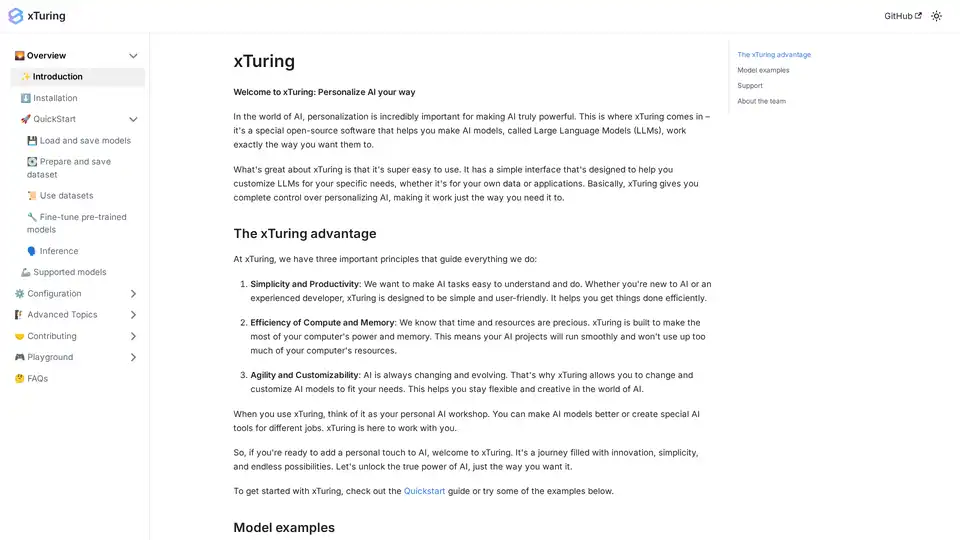
xTuring
Overview of xTuring
What is xTuring?
xTuring is an innovative open-source library designed to simplify the personalization of Large Language Models (LLMs). Developed by the team at Stochastic, it empowers developers, researchers, and AI enthusiasts to build and control custom LLMs tailored to specific needs. Unlike generic AI frameworks, xTuring emphasizes user-friendly customization, allowing you to fine-tune models on your own datasets without deep expertise in complex machine learning pipelines.
At its core, xTuring addresses a key challenge in AI: making powerful LLMs accessible and adaptable for real-world applications. Whether you're enhancing a model for niche tasks like domain-specific content generation or optimizing for resource-constrained environments, xTuring provides the tools to unlock AI's potential in a personalized way.
How Does xTuring Work?
xTuring operates as a streamlined toolkit that integrates seamlessly with popular LLMs such as LLaMA, GPT-J, Bloom, and more. Its architecture is built around efficiency and modularity, enabling users to handle the entire workflow—from data preparation to model inference—with minimal overhead.
Key Components and Workflow
- Data Preparation and Dataset Handling: Start by preparing your dataset using xTuring's utilities. It supports loading, saving, and preprocessing datasets like Alpaca, making it easy to align data with your personalization goals. This step ensures your custom model learns from relevant, high-quality inputs.
- Model Loading and Fine-Tuning: Load pre-trained models from Hugging Face or other sources. xTuring excels in fine-tuning with advanced techniques like LoRA (Low-Rank Adaptation) and INT8 quantization, which reduce computational demands while maintaining performance. For instance, you can fine-tune a 7B LLaMA 2 model on the Alpaca dataset in hours, not days.
- Inference and Deployment: Once tuned, deploy your model for inference directly within xTuring. It supports efficient memory usage, allowing inference on standard hardware without needing massive GPU clusters.
- Configuration and Customization: A flexible configuration system lets you tweak hyperparameters, enabling agile experimentation. This is particularly useful for iterative development in fast-evolving AI landscapes.
The library's principles—simplicity, efficiency, and agility—ensure that workflows are intuitive. For example, commands like xturing train handle fine-tuning end-to-end, abstracting away boilerplate code common in tools like Transformers.
Core Features of xTuring
xTuring stands out with features that prioritize productivity and performance:
- Support for Diverse Models: It works with a wide array of LLMs, including Bloom, Cerebras-GPT, Falcon, Galactica, GPT-2, GPT-J, LLaMA, LLaMA 2, and OPT. Examples include fine-tuning Falcon 7B with or without LoRA and INT8 for optimized memory usage.
- LoRA and Quantization Integration: LoRA allows parameter-efficient fine-tuning, updating only a small subset of weights, which is ideal for low-resource setups. INT8 quantization further compresses models, speeding up training and inference by up to 4x without significant accuracy loss.
- Resource Efficiency: Designed for compute and memory optimization, xTuring minimizes resource consumption, making it feasible to run on laptops or edge devices. This is a game-changer for indie developers or small teams lacking enterprise-grade hardware.
- User-Friendly Interface: With a simple API, even beginners can personalize AI. Advanced users appreciate the extensibility for custom wrappers around any LLM.
- Community-Driven Examples: Pre-built notebooks and scripts for common tasks, like fine-tuning on Alpaca, accelerate onboarding.
These features make xTuring a versatile tool for LLM personalization, reducing the barriers to entry in AI development.
Primary Use Cases for xTuring
xTuring shines in scenarios where standard LLMs fall short due to lack of specificity. Here are some practical applications:
- Domain-Specific AI Customization: Fine-tune models for industries like healthcare, finance, or legal, using proprietary datasets to create compliant, accurate assistants.
- Research and Experimentation: Researchers can rapidly prototype new adaptation techniques, testing hypotheses with LoRA on models like Galactica for scientific text generation.
- Product Development: Build chatbots, content generators, or virtual assistants tailored to user data, ensuring privacy and relevance.
- Educational Tools: Teachers and students can experiment with AI ethics or language learning by personalizing open models.
- Edge AI Deployment: Optimize models for mobile or IoT devices, where efficiency is critical.
For transactional users searching 'how to fine-tune LLM with LoRA,' xTuring provides step-by-step guides, lowering the learning curve.
Why Choose xTuring?
In a crowded AI landscape, xTuring differentiates itself through its commitment to accessibility and innovation. Licensed under Apache 2.0, it's free to use and modify, fostering a vibrant open-source community. Users praise its balance of power and simplicity—'It's like having a personal AI workshop,' as one testimonial notes.
Compared to alternatives like Hugging Face's PEFT library, xTuring offers a more integrated experience with built-in dataset handling and inference support, saving hours of setup time. Its global team from Stochastic ensures ongoing updates, keeping pace with LLM advancements.
Real-world value? Developers report 30-50% faster training times and reduced memory footprints, enabling more iterative work. For businesses, it translates to cost savings on cloud resources, while researchers gain a reliable tool for reproducible experiments.
Who is xTuring For?
xTuring is ideal for a broad audience:
- Beginner Developers: Those new to AI who want to dip into LLMs without overwhelming complexity.
- Experienced ML Engineers: Professionals seeking efficient fine-tuning for production-grade apps.
- Researchers: Academics exploring model adaptation in areas like natural language processing.
- Startups and SMBs: Teams needing customizable AI without big budgets for proprietary solutions.
- Hobbyists and Educators: Anyone passionate about AI personalization for creative or teaching purposes.
If you're searching for 'best open-source LLM fine-tuning tool,' xTuring fits perfectly, offering scalability from personal projects to enterprise deployments.
How to Get Started with xTuring
Getting up and running is straightforward:
- Installation: Install via pip:
pip install xturing. It supports Python 3.8+ and integrates with PyTorch. - Quickstart: Follow the official guide to load a model like LLaMA and fine-tune on a sample dataset.
- Explore Examples: Dive into Jupyter notebooks for LoRA experiments or INT8 optimizations.
- Community Support: Join the Discord for troubleshooting or share ideas on Twitter (@stochasticai).
For advanced users, the documentation covers loading custom datasets and configuring multi-GPU training.
Practical Value and User Insights
xTuring's real strength lies in its impact: it democratizes AI by making personalization feasible for non-experts. User feedback highlights its role in accelerating projects—one developer shared how it cut their fine-tuning time from weeks to days, enabling quicker MVP launches.
In terms of SEO for AI tools, xTuring ranks high for queries like 'open-source LLM customization library' due to its comprehensive docs and active community. Its E-E-A-T is evident in the team's expertise from Stochastic, backed by transparent licensing and ethical AI focus.
FAQs from the docs address common pain points:
- Q: Does it support quantized models? A: Yes, INT8 is built-in for efficiency.
- Q: Can I use my own data? A: Absolutely, with easy dataset preparation tools.
- Q: Is it production-ready? A: Yes, with stable inference endpoints.
Customer cases include academic papers citing xTuring for reproducible LLM experiments and startups using it for internal knowledge bases.
Conclusion: Unlock Personalized AI with xTuring
xTuring isn't just a library—it's a gateway to innovative AI applications. By prioritizing simplicity, efficiency, and customizability, it empowers you to shape LLMs that align with your vision. Whether for research, business, or curiosity, xTuring delivers tangible value in the dynamic world of artificial intelligence. Start your journey today and experience the freedom of personalized AI.
Best Alternative Tools to "xTuring"

Unsloth AI offers open-source fine-tuning and reinforcement learning for LLMs like gpt-oss and Llama, boasting 30x faster training and reduced memory usage, making AI training accessible and efficient.

Cheshire Cat AI is an open-source framework that simplifies building AI agents. It supports LLMs, external APIs, and plugins, all within a Dockerized environment for easy deployment and customization.
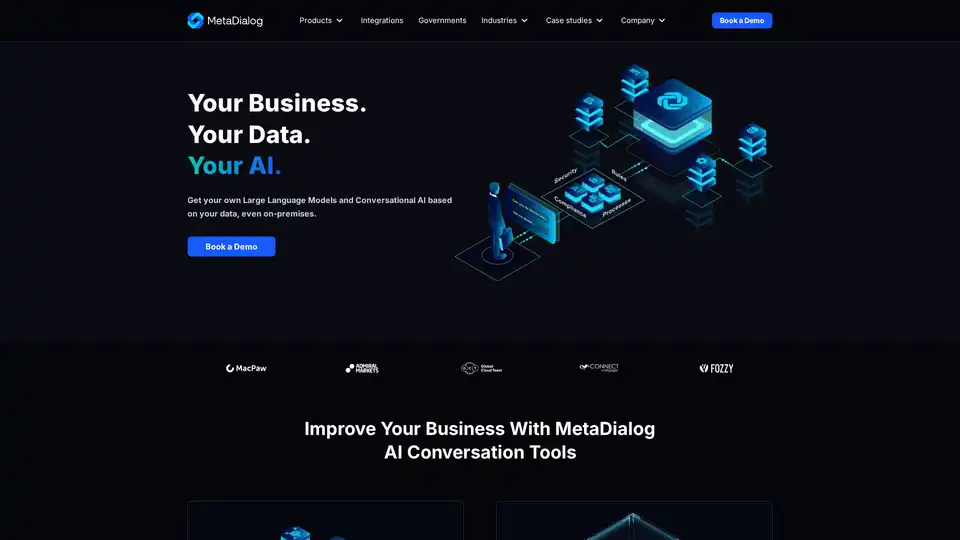
MetaDialog offers conversational AI solutions, including custom LLMs that provide secure, accurate, and compliant customer support automation and business process integration, even on-premises.
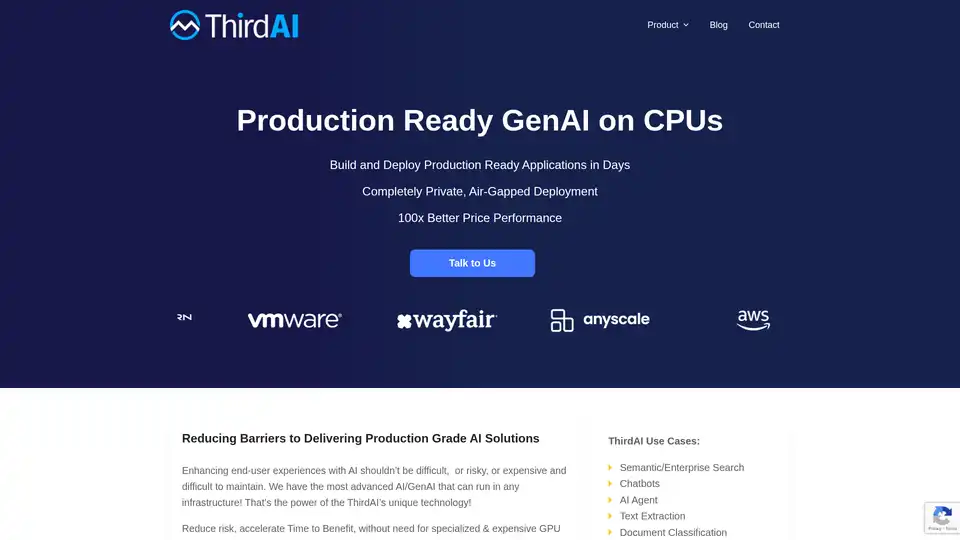
ThirdAI is a GenAI platform that runs on CPUs, offering enterprise-grade AI solutions with enhanced security, scalability, and performance. It simplifies AI application development, reducing the need for specialized hardware and skills.
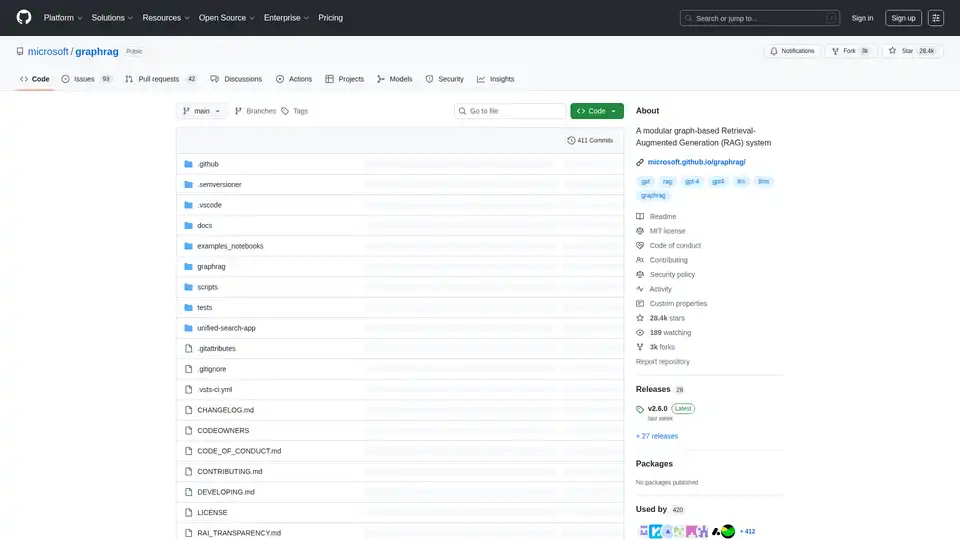
GraphRAG is an open-source, modular graph-based Retrieval-Augmented Generation system designed to extract structured data from unstructured text using LLMs. Enhance your LLM's reasoning with GraphRAG.
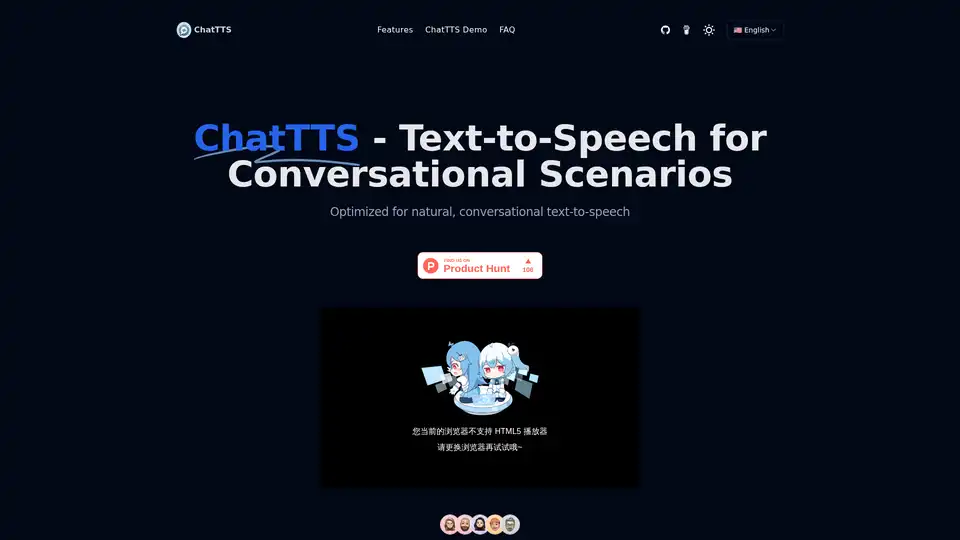
ChatTTS is an open-source text-to-speech model optimized for conversational scenarios, supporting Chinese and English with high-quality voice synthesis trained on 100,000 hours of data.

Dynamiq is an on-premise platform for building, deploying, and monitoring GenAI applications. Streamline AI development with features like LLM fine-tuning, RAG integration, and observability to cut costs and boost business ROI.

Xander is an open-source desktop platform that enables no-code AI model training. Describe tasks in natural language for automated pipelines in text classification, image analysis, and LLM fine-tuning, ensuring privacy and performance on your local machine.
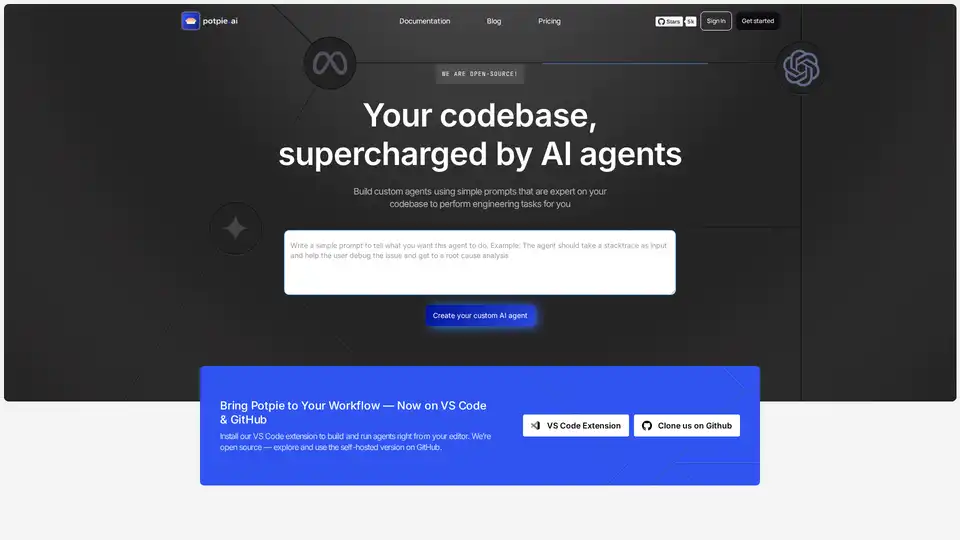
Build task-oriented custom agents for your codebase that perform engineering tasks with high precision powered by intelligence and context from your data. Build agents for use cases like system design, debugging, integration testing, onboarding etc.
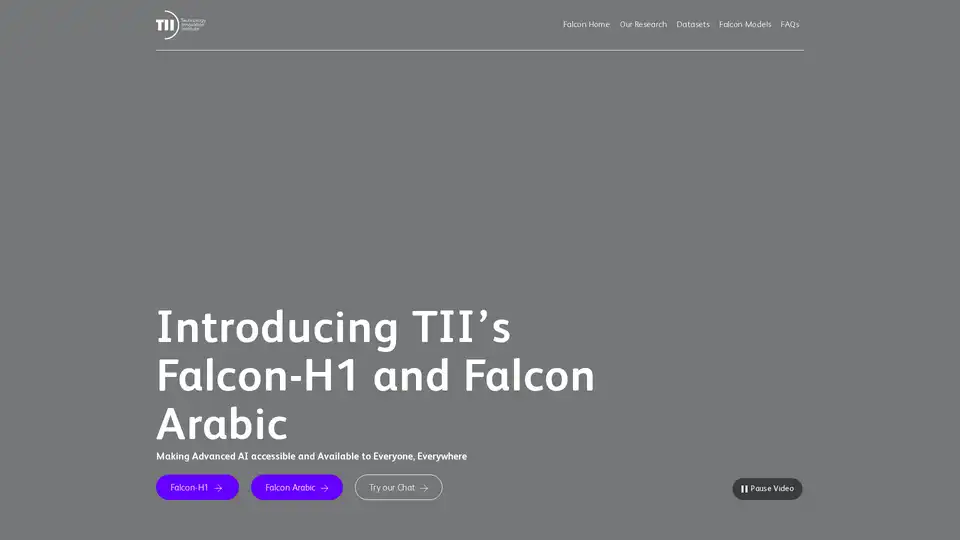
Falcon LLM is an open-source generative large language model family from TII, featuring models like Falcon 3, Falcon-H1, and Falcon Arabic for multilingual, multimodal AI applications that run efficiently on everyday devices.

PremAI is an applied AI research lab providing secure, personalized AI models, encrypted inference with TrustML™, and open-source tools like LocalAI for running LLMs locally.

Langtrace is an open-source observability and evaluations platform designed to improve the performance and security of AI agents. Track vital metrics, evaluate performance, and ensure enterprise-grade security for your LLM applications.

Oda Studio offers AI-powered solutions for complex data analysis, transforming unstructured data into actionable insights for construction, finance, and media industries. Experts in Vision-Language AI & knowledge graphs.

Wisent uses representation engineering to give you unprecedented control over AI capabilities, enhancing performance and reducing hallucinations in large language models.
